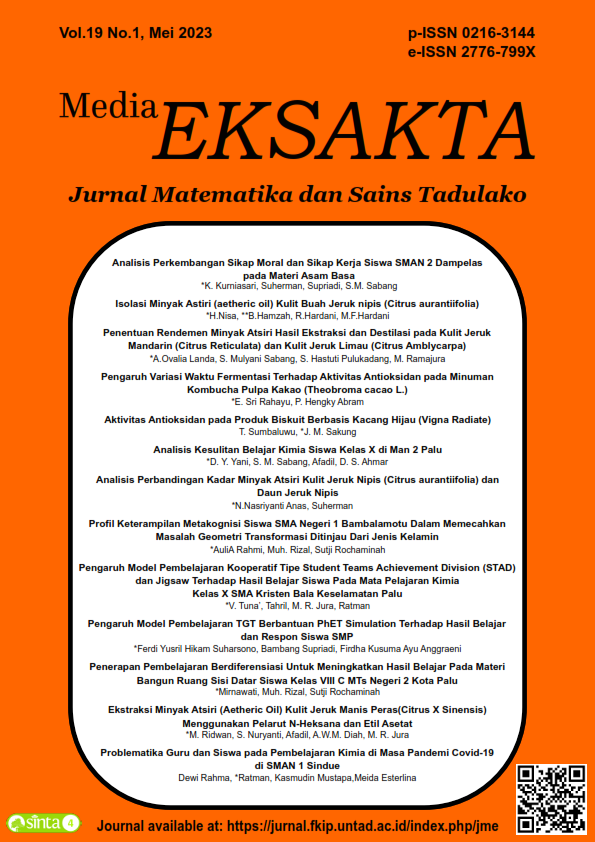Development of Practicum Tools for Measuring Temperature and Air Humidity Based on Microcontroller by Telemetric
DOI:
https://doi.org/10.22487/me.v19i1.3485Keywords:
Measuring instrument, Temperature, TelemetryAbstract
The purpose of this research is to make a temperature measuring instrument for air temperature and humidity on the device using the DHT11 sensor as a temperature and humidity sensor for the object under study, the ATMega328P CH340G microcontroller as data processing and the Bluetooth HC-05 module as an intermediary communication between the device and a smartphone. , utilizing App Inventor technology as a means of information quickly and accurately. The research method used in this study is the research and development method or known as research and development (R&D). This measuring tool is made using the Arduino Uno R3 module, which is programmed using the Arduino programming language. Based on the results of the study, it can be concluded that: 1) The measuring instrument is designed to be able to measure temperature and humidity in a place/room continuously, 2) the system can provide precise and accurate information on the temperature and humidity of the device to the user. The additional result is that apart from practical measuring tools it can also be used as a wireless monitoring tool for temperature and humidity for swiftlet houses which is useful for solving temperature and humidity problems in swiftlet houses as well as outputs of Intellectual Property Rights Products.
References
Wartono, Pengembangan Program Pengajaran Fisika. Mlaang: FMIPA UNM, 2003.
F. Kreith and A. Prijono, “Prinsip-prinsip Perpindahan Panas, edisi ketiga,” Surabaya: Erlangga, p. 13, 1997.
R. Harisuryo, S. Sumardi, and B. Setiyono, “Sistem Pengukuran Data Suhu, Kelembaban, Dan Tekanan Udara Dengan Telemetri Berbasis Frekuensi Radio,” Transient J. Ilm. Tek. Elektro, vol. 4, no. 3, pp. 651–659, 2015.
F. Djuandi, “Pengenalan Arduino,” E-book. www. tobuku, vol. 24, 2011.
D. Sugiyono, “Metode penelitian pendidikan pendekatan kuantitatif, kualitatif dan R&D,” 2013.
M. Endang, “Riset terapan bidang pendidikan dan teknik,” Yogyakarta Andi, 2011.
D. Mardapi, Penyusunan Tes Hasil Belajar. Yogyakarta: PPs Universitas Negeri Yogyakarta, 2004.
S. Arikunto, “Prosedur Penelitian Suatu Pendekatan Praktik, Jakarta: Rineka Cipta..(2013),” Prosedur Penelit. Suatu Pendekatan Prakt. Ed. Revisi VI. Jakarta Rineka Cipta, 2010.
U. Pratiwi, “Kontrol suhu berbasis arduino dengan interface Matlab sebagai alat bantu praktikum fisika dasar,” J. Pendidik. Surya Edukasi, vol. 2, no. 2, pp. 14–26, 2011.
Jamzuri, “Pembuatan Sistem Akuisisi Data Pengukur Suhu Menggunakan Labview Interface For Arduino (LIFA),” J. Mater. dan Pembelajaran Fis., vol. 6, no. 1, pp. 25–29, 2016.
A. Permatasari, Y. Yuberti, and W. Anggraini, “Pengembangan lampu sensor berbasis Arduino uno sebagai alat peraga fisika,” Indones. J. Sci. Math. Educ., vol. 2, no. 3, pp. 380–387, 2019.
M. Iqbal, Y. Yulkifli, and Y. Darvina, “Rancang Bangun Sistem Pengukuran Suhu Dan Kelembaban Udara Menggunakan Sensor Sht75 Berbasis Internet of Things Dengan Display Smartphone,” Berk. Fis., vol. 22, no. 3, pp. 97–104, 2019.
S. Suherman, I. Andriyanto, and S. Dwiyatno, “Rancang Bangun Alat Ukur Temperatur Suhu Perangkat Server Menggunakan Sensor LM35 Bebasis SMS Gateway,” PROSISKO J. Pengemb. Ris. dan Obs. Sist. Komput., vol. 2, no. 1, 2015.
M. Iqbal, “Pembuatan Sistem Pendeteksi Wajah Menggunakan Sensor Kamera Face Detector Berbasis Arduino Atmega328.” Universitas Pendidikan Indonesia, 2012.
H. Budianto and S. Winardi, “Rancang Bangun dan Web Monitoring Pengukur Temperatur Suhu untuk Peringatan pada Ruang Server Menggunakan Sensor DHT 11 dengan Modul Komunikasi Arduino Uno,” J. Univ. Narotama Surabaya, 2012.
Downloads
Published
How to Cite
License
Copyright (c) 2024 Muhammad Zaky, Nita Carolina, Unggul Wahyono

This work is licensed under a Creative Commons Attribution-ShareAlike 4.0 International License.
Authors who publish with Jurnal Media Eksakta agree to the following terms:
- Authors retain copyright and grant the journal right of first publication with the work simultaneously licensed under a Creative Commons Attribution License (CC BY-SA 4.0) that allows others to share the work with an acknowledgment of the work's authorship and initial publication in this journal.
- Authors are able to enter into separate, additional contractual arrangements for the non-exclusive distribution of the journal's published version of the work (e.g., post it to an institutional repository or publish it in a book), with an acknowledgment of its initial publication in this journal.
- Authors are permitted and encouraged to post their work online (e.g., in institutional repositories or on their website) prior to and during the submission process, as it can lead to productive exchanges, as well as earlier and greater citation of published work.




